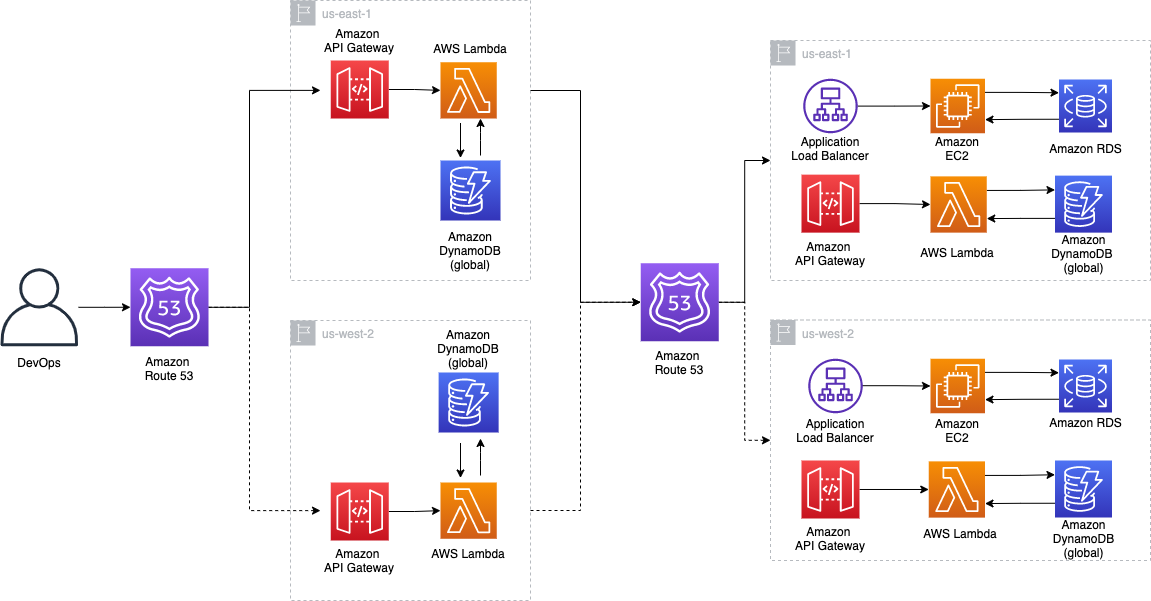Crafting Resilience: Unveiling the Power of AWS Disaster Recovery Strategy in a Multi-Site Environment
 Sumit Mondal
Sumit Mondal
Introduction
In the dynamic realm of cloud computing, where downtime is not an option, organizations are increasingly turning to robust disaster recovery strategies to ensure business continuity. Amazon Web Services (AWS), a key player in the cloud services domain, offers a comprehensive set of tools and features for crafting an effective disaster recovery plan. In this blog, we will delve into the intricacies of AWS Disaster Recovery Strategy with a focus on Multi-Site configurations, exploring real-world examples and hands-on approaches to fortify your organization against unforeseen disasters.
Understanding Disaster Recovery on AWS
Disaster recovery (DR) involves preparing for and mitigating the impact of unforeseen events that can disrupt normal business operations. AWS, with its global infrastructure, provides a reliable foundation for building resilient architectures. In a Multi-Site disaster recovery strategy, the emphasis is on distributing resources across multiple geographically dispersed locations, reducing the risk of a single point of failure.
Key Components of AWS Disaster Recovery Strategy
Amazon S3 Cross-Region Replication (CRR):
One of the cornerstones of a Multi-Site disaster recovery plan is data redundancy across geographically separated regions.
Amazon S3 CRR allows automatic replication of data between source and destination S3 buckets in different AWS regions.
Example: Imagine a scenario where your primary data center is in the US-East region. Using S3 CRR, you can replicate critical data to a secondary bucket in the EU-West region, ensuring data durability and availability even if one region experiences an outage.
AWS Backup:
AWS Backup simplifies the process of backing up and restoring data across AWS services.
With its centralized management, you can create backup plans that define how frequently backups are taken and how long they are retained.
Example: Consider an organization running critical workloads on Amazon RDS. AWS Backup allows you to create automated backups and cross-region copies, ensuring that your database backups are stored in a different region for enhanced resilience.
Amazon Route 53:
DNS plays a crucial role in disaster recovery scenarios by enabling traffic rerouting to healthy endpoints.
Amazon Route 53, AWS's scalable domain name system, facilitates the creation of failover and latency-based routing policies.
Example: In the event of a primary site failure, Route 53 can automatically redirect traffic to a standby site, minimizing downtime and ensuring a seamless experience for end-users.
Hands-On Approach: Setting Up Multi-Site Disaster Recovery
Let's walk through a hands-on example of setting up a Multi-Site disaster recovery configuration using AWS services.
Scenario:
Primary resources in US-East (Virginia) region
Secondary resources in EU-West (Ireland) region
Steps:
Amazon S3 Cross-Region Replication:
Create a new S3 bucket in the EU-West region as the destination bucket.
Enable Cross-Region Replication on the source bucket in the US-East region, specifying the destination bucket.
# Example AWS CLI Command
aws s3api put-bucket-replication --bucket SOURCE_BUCKET_NAME --replication-configuration file://replication-config.json
AWS Backup:
Navigate to the AWS Backup console and create a backup plan for the relevant resources.
Specify cross-region copying settings to ensure backups are stored in the secondary region.
# Example AWS CLI Command
aws backup create-backup-vault --backup-vault-name VAULT_NAME
Amazon Route 53:
Create a health check for the primary site's resources.
Configure a failover policy in Route 53 to redirect traffic to the secondary site in case of a health check failure.
# Example AWS CLI Command
aws route53 create-health-check --caller-reference 1234 --health-check-config file://health-check-config.json
Conclusion
AWS provides a robust set of tools and services to build a resilient Multi-Site disaster recovery strategy. By combining features like Amazon S3 Cross-Region Replication, AWS Backup, and Amazon Route 53, organizations can fortify their infrastructure against disasters and ensure uninterrupted business operations. The hands-on example presented here is just a glimpse of the possibilities that AWS offers for crafting a comprehensive disaster recovery plan tailored to your organization's needs. Embrace the power of AWS to navigate the complex landscape of disaster recovery with confidence and resilience.
Subscribe to my newsletter
Read articles from Sumit Mondal directly inside your inbox. Subscribe to the newsletter, and don't miss out.
Written by

Sumit Mondal
Sumit Mondal
Hello Hashnode Community! I'm Sumit Mondal, your friendly neighborhood DevOps Engineer on a mission to elevate the world of software development and operations! Join me on Hashnode, and let's code, deploy, and innovate our way to success! Together, we'll shape the future of DevOps one commit at a time. #DevOps #Automation #ContinuousDelivery #HashnodeHero